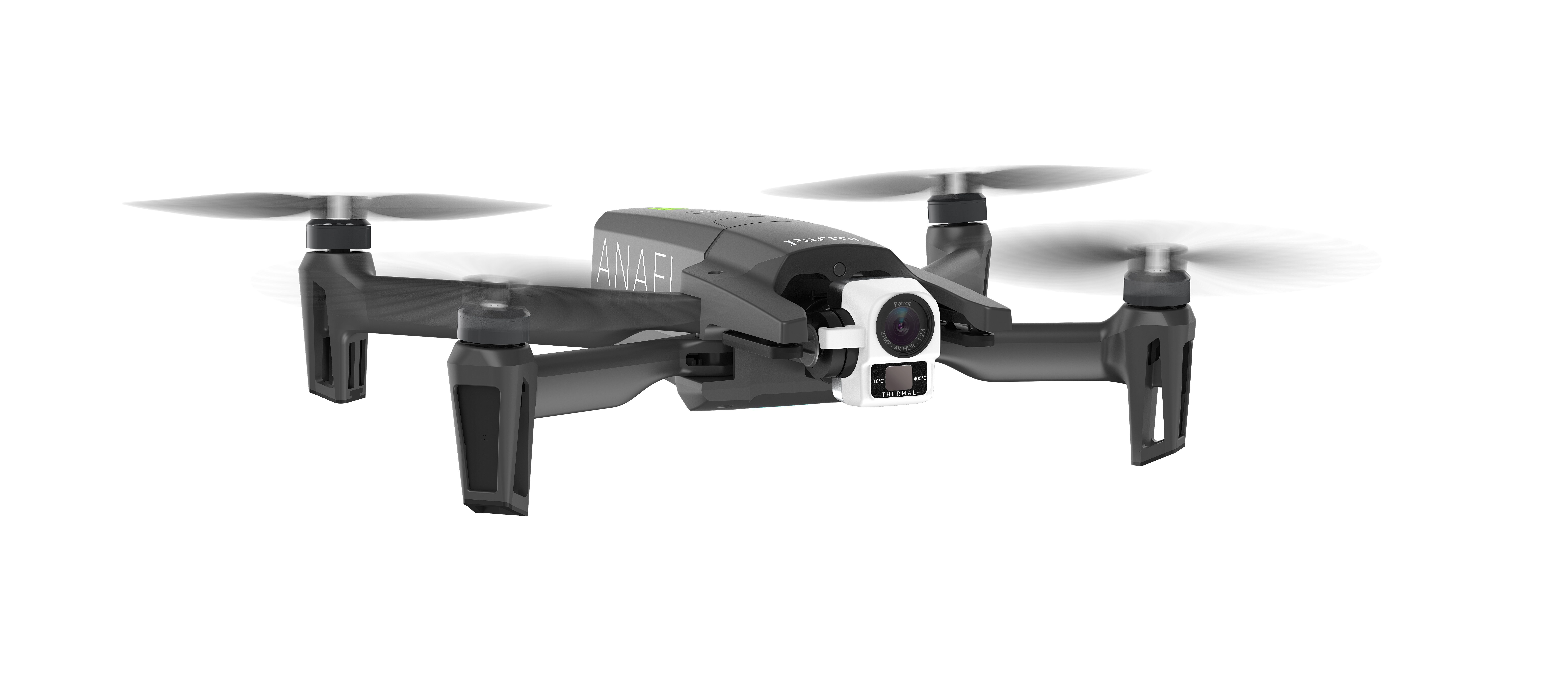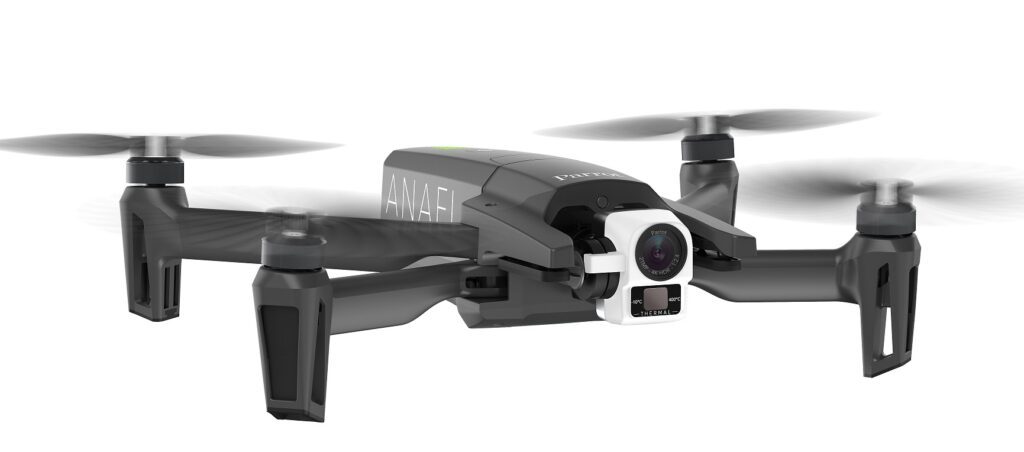French drone industry heavyweight Parrot has today announced the launch of a new commercial drone, the Anafi Thermal. The model is based on an adapted version of the Anafi platform and combines a FLIR radiometric thermal-imaging unit with a standard 4K camera.
Dronelife took the Anafi thermal for a test flight in London last week. Most impressive was the user interface of the revamped FreeFlight 6 app. The amount of different options and tools within the thermal imaging interface – as well as the intuitive way they are applied and navigated – promise to simplify thermal imaging for even the most ardent of technophobes.
Also notable is the value of the package. For £1,700 / $1,900 enterprise customers get the drone (obviously), the Parrot SkyController 3, a compact shoulder bag, a 16GB SD card, a bunch of accessories and, most importantly, 3 batteries. Combined they give the Anafi Thermal well over an hour of flight time.
There is no doubt that the package offers very good value for money. Read on for full details.

An adaptable thermal drone
Parrot’s Anafi Thermal continues what has become an industry trend: repurposing consumer platforms with a few hardware and software adaptations.
This trend highlights two realities. First, that with a few tweaks many consumer drones are smart and capable enough to be considered as industrial tools. And second, that slow-selling or ageing consumer models can find a new lease of life once adapted to perform specific tasks.
Although the Anafi platform was only launched last year, Parrot confirmed to Dronelife that the goal was always to build a platform that could go be adapted to suit both the consumer and enterprise markets. The standard Anafi is a great drone that is easy to use, quick to launch, highly portable and strong in terms of flight time – so it’s a solid base to build upon.
And, the addition of FLIR hardware and some very intuitive software features means it still feels like a purpose-built tool. The Anafi Thermal gimbal now embeds two built-in miniature cameras: A FLIR radiometric thermal-imaging camera (resolution 160×120 / temperature range -10° to +400°C) and a 4K HDR camera with 21MP Sony sensor.
It reveals the invisible and gives live temperature readings, allowing pilots to instantly identify hotspots, areas of heat loss or gain, and isolate subjects from their surroundings based on temperature.
All of those new capabilities are backed up by Parrot’s range of autonomous flight modes. We were also promised that new features and updates are planned in future and that they will come at no extra cost to Anafi Thermal pilots.
Parrot’s target market for the Anafi Thermal is broad: inspection teams, search and rescue, first responders, conservation groups. scientific research. The team explained that in the weeks before they’d used the new drone to support conservation efforts in South Africa and inspect a volcano from above.
The Anafi Thermal can also be used to build 3D images of structures and sites when used with the Pix4DModel app.
Finally, there are a couple of technical features that follow on from the initial Anafi drone. First, the gimbal can vertically tilt to +/-90°. This makes it possible to inspect beneath structures – in ‘Zenith View’ and directly above roofs and flat surfaces in ‘Nadir View’. This flexibility is bound to come in handy for engineering teams.
There’s also the x3 digital zoom, which brings forward hard-to-reach elements without the pilot needed to take unnecessary risks.
Read more: FLIR Makes Strategic Investment in DroneBase: Collaboration on Products and Training
Hardware Specs
Like the original Anafi, the Anafi Thermal is compact, lightweight, powerful and portable. Despite the extra FLIR unit, it’s actually a few grams lighter than the original (315g). This provides an extra minute of flight time (26 per battery) and a top speed of 55km/h and it withstands winds of up to 50km/h (34 mph).
With three batteries included as part of the package, pilots have 1.25 hours (78 minutes) of cumulative flight time at their fingertips.
The batteries can be charged directly with a USB-C connection. The Parrot Skycontroller 3 remote control gives a range of up to 4km (2.48 miles), ensuring teams can remain at a safe distance from at-risk or difficult to access areas. The transmission system uses Wi-Fi protocols developed by Parrot.
Accessible thermal imaging
The Anafi Thermal comes with an easy-to-use application that’s intuitive without being limiting. There is plenty of depth to the tools on display. Pilots can switch from thermal imaging to the RGB view or merge the two with the touch of a button.
There’s also scope for analysis in real-time. The display gives a temperature estimate of a particular point with a single tap on the screen, frames can be frozen to remove any element of doubt and there are three groups of settings available:
- Relative: the scene is colored with a gradient color scale from the coldest temperature on the scene to the hottest. This group displays the full extent of temperature differences.
- Absolute: the user manually chooses the temperature range of the color gradient to highlight specific areas.
- Spot: this mode is used to instantly identify thermal anomalies. Only the hottest or coldest spots are isolated.
The Downsides
There are three things that could hold the Anafi Thermal back versus its competition.
First, the controller has remained the same from the original consumer model. It’s not that there’s anything particularly wrong with it. But it does feel oversized and toy-like, rather than the sleek, solid alternatives DJI now offers. Commercial drone use is not a fashion show however, so this is just an aesthetic point.
The second issue is entirely practical in nature. Just like its base platform, the Anafi Thermal has limited safety features. There is no obstacle detection or avoidance, so in theory it’s much easier to crash (and break) than similar models on the market.
Having said that, the Anafi Thermal does have some failsafes in place to prevent accidents. You can set an exact flight altitude for the drone to maintain, draw up your own geo fence and create a flight plan to remove the need for manual control. There’s also a Return Home function activated with the press of a dedicated button.
The third challenge facing the Anafi Thermal is, obviously, the DJI Mavic 2 Enterprise Dual. The M2ED has neither of the drawbacks mentioned above and can also be used with DJI’s range of enterprise accessories, which include a spotlight and a speaker.
However, the M2ED package comes out at $2,699, significantly more than the $1,900 Anafi Thermal. So long as you only have a single use case in mind for your thermal imaging drone, the Anafi arguably represents better value for money. Particularly with three batteries included. But how compelling that price difference seems will depend on the applications you have in mind.
SAR teams, for example, may see the extra value in a drone that can use a range of accessories alongside the thermal imaging. While a solar panel inspection crew can do without those bells and whistles.
Anafi Thermal: Price and Availability
Parrot’s Anafi Thermal will be available from the end of May 2019 via Parrot.com and official Parrot resellers. UK buyers can get the bundle for $1,900, £1,700.00 excluding VAT or 1,900€.
Malek Murison is a freelance writer and editor with a passion for tech trends and innovation. He handles product reviews, major releases and keeps an eye on the enthusiast market for DroneLife.
Email Malek
Twitter:@malekmurison
Subscribe to DroneLife here.
